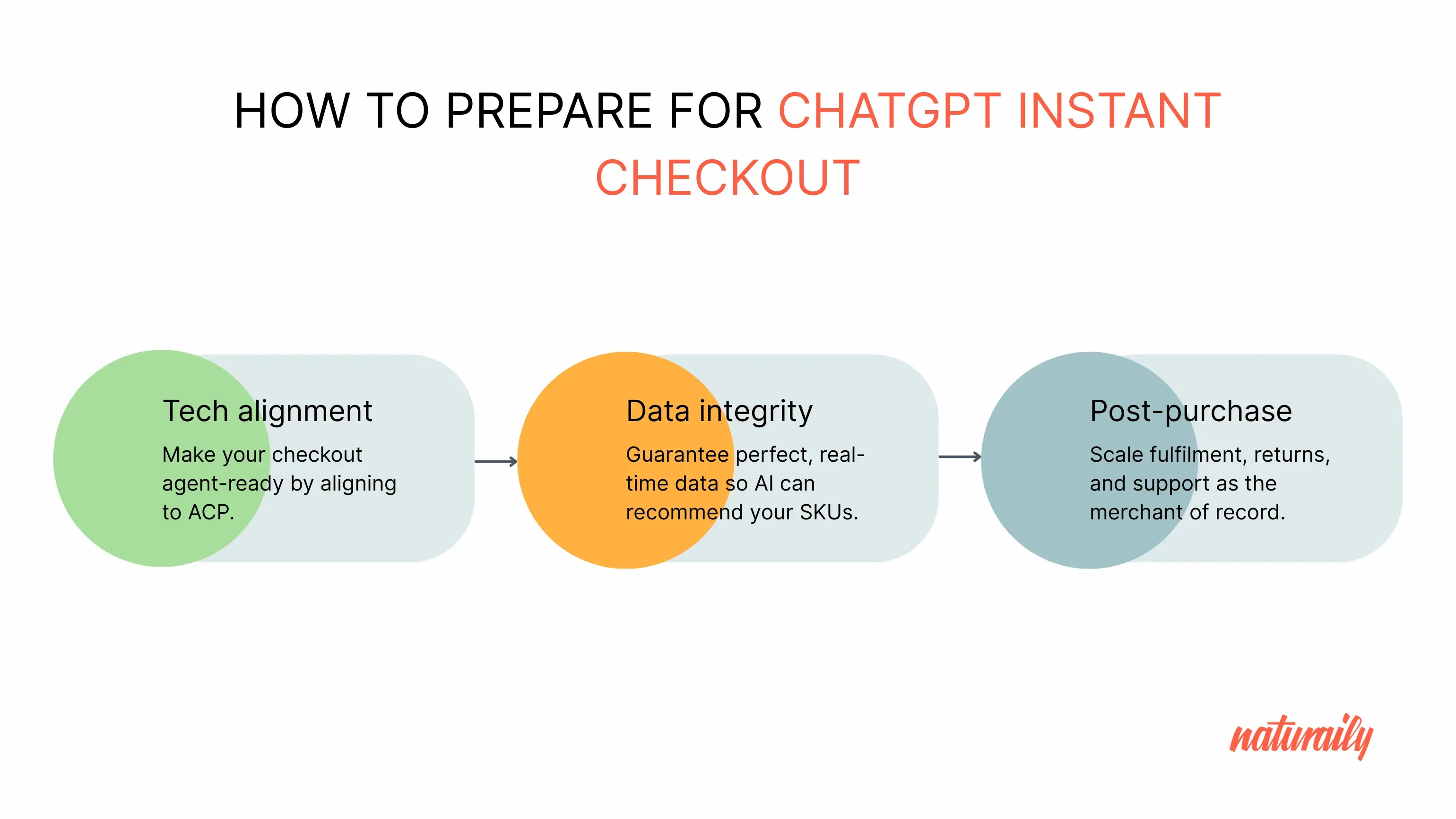Are You Ready for ChatGPT Instant Checkout? A Shopify Merchant’s Playbook for What to Fix First
ChatGPT's new Instant Checkout feature is changing how people shop online. More consumers now turn to AI tools when making purchase decisions, discovering products through chatbot interactions rather than conventional search or ads. Shopify wants to ensure its million-plus merchants can sell wherever these AI conversations take place.

TL;DR (for busy teams)
ChatGPT’s new Instant Checkout moves e-commerce from “search & browse” to conversational, agent-driven buying. Shoppers ask, get a recommendation, and complete the purchase inside the chat interface. To be ready on Shopify you should:
Align to ACP (Agentic Commerce Protocol) so your checkout is agent-ready (simple if you already use Stripe; clear paths exist for others).
Guarantee perfect, real-time product data and apply Semantic Product Optimization (SPO) so AI can “understand” and recommend your SKUs.
Scale post-purchase ops - you remain the merchant of record for fulfillment, returns, and support; excellence here drives loyalty and LTV.
At launch, scope prioritizes single-item purchases, so start with SKUs that convert well on their own.
Why ChatGPT's Instant Checkout Matters Now
E-commerce is shifting from destination sites to conversational discovery. Instead of optimizing only the page someone lands on, you’re optimizing what the AI recommends, and whether it can complete a purchase instantly. The “chat → checkout in a few taps” experience compresses your funnel, so data accuracy and agent-ready plumbing become revenue-critical.
If you run a Shopify store, make sure you’re ready for this new sales channel. But preparation goes beyond the technical setup.
Shopify merchants should prepare for ChatGPT's Instant Checkout by focusing on three key areas: technical alignment, data integrity, and post-purchase logistics. This feature is moving away from the traditional model where customers search and navigate to specific destinations, toward a conversational, AI-driven approach where products are discovered directly through chat interactions.
Ensure your checkout systems are AI-ready
Optimize product data so AI can effectively recommend your items
Strength your shipping and customer service operations
Merchants need to shift their focus from traditional SEO to making their product data crystal clear and easily accessible for AI systems. Since customers can now go from chat to checkout "in just a few taps," the entire buying process happens almost instantly, which means the product data feeding these AI systems has to be flawless.
Nanobébé needed a modern, high-converting store to match their global growth. We rebuilt their Shopify site with sleek UX and faster load times. This made shopping easier and more engaging for parents worldwide.
5/5
Clutch review
117%
increased performance
80%
reduced TBT

What Exactly Is ChatGPT Instant Checkout (and ACP)?
Instant Checkout lets shoppers purchase the products recommended in chat without leaving the conversation. It’s e-commerce embedded in dialog.
The plumbing behind this is the Agentic Commerce Protocol (ACP) - an open standard (Apache 2.0) from Stripe & OpenAI that shows businesses how to make checkouts agent-ready so AI agents can transact programmatically and safely across compliant retailers.
Why it’s different: Instead of bespoke, brand-specific flows, ACP enables consistent, programmatic commerce via agents.
Areas to Prepare (Start Here)
Here are the key preparation strategies for Shopify merchants:
1. Technical alignment to achieve "agent-ready" status
The core technical requirement is to comply with the Agentic Commerce Protocol (ACP), an open standard that enables AI agents to execute secure transactions.
For merchants using Stripe preparation is simplified. Enabling agentic payments may require "as little as one line of code," making this the lowest-friction path to compliance.
For merchants using other payment processors: You can still participate but must take alternative steps. You can either use Stripe's new Shared Payment Token API or directly implement the open ACP specification yourself.You need to evaluate the resources needed for custom integration versus other options.
Security & trust requirements
Agent-initiated transactions demand that you can confirm purchases, accept credentials securely, and meet evolving trust controls. Audit and stress-test checkout APIs to align with ACP security expectations and avoid fraud or failures.
The way people shop online is changing forever, moving from search and browse to AI-driven conversations.

Marcin Sulikowski
co-CEO, Naturaily
2. Data integrity and semantic product optimization (SPO)
Because the AI agent is recommending products based on the query and existing data, the integrity of pricing, inventory, and variant data must be real-time and structured for immediate comprehension by the AI.
This is likely to be the most time-consuming and ongoing task. Merchants must achieve "perfect, instantaneous synchronization" of all product data. The process involves meticulous structuring of data with rich semantic attributes, which is a significant undertaking rather than a quick fix.
Ensure real-time data purity
The AI relies on real-time data for pricing, inventory levels, images, and product variants. Any discrepancy, such as an outdated price or an out-of-stock item being recommended, can lead to a failed transaction, customer frustration, and potential exclusion from future AI recommendations.
Structure data for AI comprehension
Products must be presented "in a format that AI understands". This involves using rich, unambiguous semantic attributes, including detailed metadata, image alt-text, and clear variant and category definitions. This practice, called Semantic Product Optimization (SPO), becomes the primary competitive differentiator for being seen by the AI shopper agent.
In the agentic model, poor or non-real-time data makes products invisible to the AI shopper. Data governance and SPO become core competitive moats.

Marcin Sullikowski
co-CEO, Naturaily
Prioritize single-item purchases
Initially, the Instant Checkout feature will only support single-item purchases. Merchants should identify their best-selling products that work well as standalone purchases and prioritize them for data and technical optimization to maximize immediate returns.
3. Post-purchase logistics and customer relationship management
A key aspect of the Shopify integration is that merchants remain the "official merchant of record" and retain full control over fulfillment, returns, support, and all subsequent customer communication.
Scale fulfillment and logistics
The frictionless, "few taps" checkout process may lead to a significant increase in transaction velocity. Merchants need to ensure their fulfillment systems are prepared to handle a potential surge in single-item orders without compromising delivery speed.
Optimize for returns and support
The ease of impulse purchasing may lead to a higher volume of returns. Get ahead of it by tightening your reverse-logistics process and setting up proactive support for Instant Checkout orders.
Reinforce brand and customer relationships
AI may drive the initial sale, but you own the relationship that follows. Since your store name is front and center at checkout, make sure your brand voice is clear and memorable. Back it up with excellent post-purchase care, and you’ll turn quick chat-driven transactions into long-term loyalty.

4. Strategic and financial preparation
Re-evaluate customer acquisition costs
Merchants will pay ChatGPT a "small fee" for completed transactions, which will be transparently shown in the Shopify admin panel. This fee should be analyzed as a performance-based customer acquisition cost and compared to existing expenses like paid search or social media ads.
Embrace the conversational funnel
Merchants must recognize they are no longer just competing for SEO rankings but for recommendation slots in an AI dialogue. The focus shifts from optimizing a landing page to optimizing the product data that secures the AI's recommendation.
What are the Main Rules of Instant Checkout?
1. The merchant is always the merchant of record
One of the core principles of this system is that Shopify merchants keep full ownership and responsibility for the post-purchase experience.
Merchants are solely responsible for order fulfillment
All customer support inquiries and the entire returns process are managed by the merchant
The merchant owns the long-term customer relationship and all subsequent communication
Orders appear directly in the merchant's Shopify admin interface for management
2. Adherence to the Agentic Commerce Protocol (ACP) is mandatory
The entire system operates on a new open standard called the Agentic Commerce Protocol (ACP). Compliance is a non-negotiable technical rule.
The ACP provides a blueprint for how AI agents can perform secure, programmatic transactions with businesses.
3. Product discovery is driven by real-time, AI-readable data
Since the AI agent can only recommend products based on the data it sees, the accuracy and structure of your product information are critical for visibility.
Shopify powers the AI's discovery with real-time data on pricing, inventory, images, and product variants. Any discrepancy, such as an incorrect price or an out-of-stock item, can lead to a failed transaction and cause the product to be excluded from future recommendations.
Semantic optimization: Products must be presented "in a format that AI understands". This requires structuring data with rich, unambiguous semantic attributes, a practice known as Semantic Product Optimization (SPO). Poor data quality can make a product effectively invisible to the AI shopper agent.
| Traditional | AI-driven | |
|---|---|---|
| Channel | Paid search, social | ChatGPT recommendations |
| Cost model | Pay-per-click | Pay-per-sale |
| Optimization | Landing page SEO | Semantic product optimization (SPO) |
4. The transaction is limited to a single item
A key operational rule, at least for the initial launch, is the scope of the transaction. The Instant Checkout feature only supports single-item purchases. The capability for multi-item shopping carts is planned for future updates.
5. Transactions incur a performance-based fee
There is a clear financial rule for using this new sales channel.
Merchants will pay ChatGPT a "small fee" for completed transactions
These fees and the order attribution will be shown transparently in the merchant’s Shopify admin panel. This fee should be treated as a performance-based customer acquisition cost.
Compare this fee’s effective cost of acquisition (eCOA) to your current paid search, social, or affiliate spend. If eCOA is lower and volume is high, shift budget and inventory toward chat-ready SKUs.
6. The merchant's brand is always visible
While the transaction occurs within the AI chat, the system is designed to ensure the customer knows who they are buying from.
The merchant's store name is prominently displayed during the checkout process. This rule helps build trust and reinforces brand integrity at the final point of purchase.
The Competitive Advantage of Moving Fast
Shopify's promise is to keep merchants "on the cutting edge by default," but default doesn't mean passive. The merchants who actively prepare will capture disproportionate value in the early days of this channel.
ChatGPT has hundreds of millions of users who increasingly rely on it for purchase decisions. Being among the first merchants to offer seamless, reliable Instant Checkout experiences means:
First-mover advantage in AI recommendations
Building trust signals that compound over time
Learning and optimizing while competition is still catching up
Establishing your brand as innovation-forward
Scope & prioritization (what to ship first)
At launch, Instant Checkout supports single-item purchases. Prioritize SKUs that win alone (hero products, replenishable goods, popular gifts). Then prepare to expand as multi-item carts roll out.
Build a “Recommended via Chat” collection: high-velocity SKUs with spotless data, rich attributes, and on-brand micro-copy that reassures in a small UI.
Practical Checklist
[ ] ACP compliance path selected and implemented (Stripe or ACP/Shared Token)
[ ] 100% real-time price, inventory, variant sync; SPO audit complete
[ ] Top SKUs tagged “chat-ready” with rich attributes and brand micro-copy
[ ] Fulfillment & returns scaled for single-item order spikes; support macros live
[ ] Security: API hardening, purchase confirmations, credential handling verified
Your Next Move
While we're focusing on immediate preparation for Instant Checkout,also consider the longer trajectory. The current single-item purchase limitation will evolve to support full shopping carts. Geographic restrictions will lift. Other AI agents will adopt the ACP standard.
Start with data quality. Move quickly on technical requirements, especially if you're already using Stripe. Scale your operations thoughtfully, knowing that success might come faster than expected. And always remember: while AI might handle the transaction, you still own the relationship.
The conversational commerce revolution is here. The only question is: will you be ready when ChatGPT starts recommending your products?
FAQ
FAQ
Get a Fast Storefront
Speed = sales. We design and ship headless storefronts that load fast and convert better.

